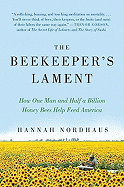
The Beekeeper's Lament is a deceptively calm rendering of the history of the honey bee in the United States. Nordhous instructs her readers in the bee's biology, but most importantly, in the pathogens and pests assaulting the honey bee. The creature is susceptible to a frightening array of diseases, like foulbrood, known to the ancients, to the more modern attacks of the Arroa and other mites, to "multiple viral, bacterial... and fungal infections" and, most alarming of all, to syndromes such as Colony Collapse Disorder (CCD), in which the entire hive vanishes. Nordhous follows "bee guy" John Miller in his seasonal endeavors, from everyday hive maintenance to the challenges of shifting thousands of hives, insuring a seamless alignment of bee proximity to the plant flowerings, which are dependent upon them.
Geneticists and bee guys alike are working feverishly to find sustainable solutions to the honey bees' problems; most agree that agricultural monoculture, with pesticide use, exacerbates the difficulties facing the bee. This urgency is not merely about loss of honey for consumers or livelihoods of thousands; even though the famous statement attributed to Einstein--"If the bee disappears from the surface of the Earth, man would have no more than four years left to live"--is not his, the fact remains that it is true and posits a very different future for us. Most likely, no one solution will emerge to help the honey bee, but there is some small degree of comfort in knowing that researchers and beekeepers are tireless in their pursuit of any avenue that may bring them closer to restoring the bees' health. --Judith Hawkins-Tillirson, proprietress, Wyrdhoard books, and blogger at Still Working for Books

